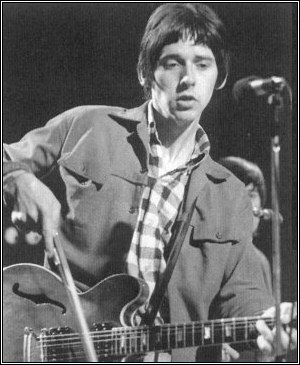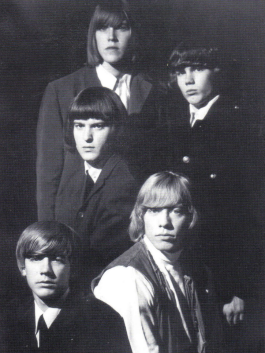Several years before the birth of heavy metal, in a time that is now recognized as the beginnings of punk rock, there existed various styles of aggressive and energetic guitar rock. On the English side of the Atlantic, young musicians were plugging in to a rock and roll band format but playing African American blues. Other bands were into the Mod beat music scene. Then one day, Ray Davies heard the American garage rock classic song “Louis Louis” and decided to try to write his own riff rock number. The result was the 1964 hit “Girl You Really Got Me” and its sibling “All Day and All of the Night”. This in turn inspired Who guitarist Pete Townshend to write “Can’t Explain”. In the final months of 1964, a single American garage rock hit had inspired three English riff rock classics.
Meanwhile, across the Atlantic Ocean in the U.S. of A, garage rock bands who were busy tinkering with classic 50’s rock and roll, frat rock, and surf rock and turning it into proto-punk garage rock got a taste of the British Invasion. Beatles’ popularity aside, it was the likes of The Rolling Stones, The Kinks, The Who (self-described purveyors of “maximum R&B!”) and The Yardbirds that intrigued many bands to take on the English renditions of American blues and give these songs a shot of their own juice. Thus as the American garage rock scene was building up to boiling over, many bands took a decided and guided turn into adding English R&B to their set lists.
A big kick to both sides came in 1965. Previously used by select artists as an effects device for an occasional song or instrumental track, the fuzz box gained overnight popularity when The Rolling Stones’ new single “(I Can’t Get No) Satisfaction” with its fuzz-toned memorable riff hit the charts. Before 1965 was over, bands on both sides of the Atlantic were testing the capacities of their speakers with the alien buzzing of the fuzz box.

Were they loud to compete with the Boeings? The Sonics from Tacoma, Washington.
On the American side, Tacoma Washington’s The Sonics were already well-versed in overdriven, over the top classic rock and roll covers, giving them an unbridled, feral injection of power. Their 1964 single “
The Witch” loudly proclaimed what this band was capable of and fully intended on doing, which was to push the needle into the red as far as possible. Back in jolly old England,
The Pretty Things were turning their R&B sound into something grittier and dirtier, a sound that matched the image the band was also earning for themselves. Ronnie Wood started up his first recording band,
The Birds, a band that frequently put an emphasis on hard-hitting guitars. Their cover of “Leaving Here” in 1965 would later be covered by
Motorhead for their debut single.

The Pretty Things: making long hair for men trendy since 1965.
In 1965, The Yardbirds lost Eric Clapton but gained Jeff Beck. Beck’s contribution to the band would be a harder edged sound with frequent diversions from standard English R&B to something that permitted fuzz box experimentation and loud, resonating power chords. Their urgent and charging cover of Johnny Brunette’s cover of “
Train Kept A-Rollin’” became an inspiration to future bands and was covered in the 70’s by Aerosmith and Motorhead.
The typical sound set up of bands at this time, regardless of their preferred style(s), was a four or five member band with drums, bass, vocals and then usually either two guitars – one clean rhythm and one lead guitar often employing fuzz tone – or a keyboard. The Music Machine and The Seeds, both of California, chose Farfisa organs while The Artwoods in the U.K. had a young Jon Lord on Hammond organ. Original songs were typically about unfaithful girls. Some bands experimented with a harder, more aggressive sound for some of their songs while others may have only ever recorded a song or two that even come close to the proto-punk, proto-metal arena. Australia’s The Easybeats – featuring George Young, older brother to Malcolm and Angus Young of AC/DC fame – hit a few upbeat guitar rockers but changed their sound with the times. Meanwhile Eric Clapton left the Yardbirds when he felt they were not truly dedicated to the blues after recording the chart-making “For Your Love”. Still, bands like The Sonics, The Seeds, and The Troggs caught attention exactly because they went for volume, grit and edge.

They should have put the all of the taller guys in the back. Chicago’s The Shadows of Knight.
It was 1966 when this transatlantic breed of music hit its undisputed peak. From the American garage rock perspective, many bands began at last to release albums.
The Remains released their one and only album,
The Shadows of Knight released two long-players that year, and The Music Machine released an album in December. That last band deserve mention in particular because they combined the garage rock sound with the emerging psychedelic rock sound. They dressed all in black and dyed their hair black, down-tuned their instruments a semi-tone and built their own fuzz box. While their teen angst song “Talk Talk” became their one big hit, the band recorded mostly mature and intelligent songs about various topics such as women’s liberation, food waste, and environmental abuse. A good number of their songs feature heavy,
fuzzed out guitar and leader Sean Bonniwell’s powerful, and at times acerbic vocals.

Making black the new black: The Music Machine
Another band that was about to blow the music apart but whose candle was snuffed out on the brink of stardom was California’s
The Misunderstood. Originally a band chiefly inspired by The Yardbirds, The Misunderstood gained good fortune at each time their first two guitarists had to leave for the draft. The first time, they gained steal lap guitarist Glenn Campbell and the second time they gained English lead guitarist Tony Hill, who later formed the progressive heavy rock band High Tide. The band were in London, struggling to get a record deal when Hill joined and the chemistry between him and singer Rick Brown buzzed so well that they wrote out a song on the same day. Their rare six-track recording in London combined blues-inspired rock with a heavy flower power sound that was unlike anything in their day. No one would come close to that sound until at least 1968. Unfortunately for them and us, Brown was drafted and the band collapsed.

Taking the long hair thing one step further: Q65 of the Netherlands
While garage rock was chiefly an American (and also Canadian) phenomenon and R&B had found a new sound in English rock bands, this music was not limited to two or three countries. There was a kind of zeitgeist that inspired teens and twenty-somethings around the world to try to play this more aggressive style of guitar rock. From
Iceland to the
Netherlands, from
Australia and to
Japan, fuzz-toned guitar rockers were cropping up everywhere. Some followed the garage rock sound, others went for the English R&B sound. Still others fused the emerging psychedelic sound into their songs. Not everyone was going for the level of intensity that The Sonics were and not everyone was trying to be the baddest boys on the block. For most bands, the pursuit of the chart-topping single was still paramount because it would mean the record company would be happy and there would be money to allow the bands to record more music. However, the desire to play harder, louder, heavier, and with more energy was made apparent in songs like “Louis Louis” as covered by The Sonics or
The Troggs,
The Yardbirds “I Ain’t Done Wrong”, Q65’s “Cry in the Night”, or
Guess Who’s “It’s My Pride”.

The Yardbirds once boasted having Jeff Beck and Jimmie Page in the band.
The band who best brought heavy to a new definition had to have been Cream. Though their debut album in 1966 was essentially a blues album, the whole sound of the album was unlike anything that had gone before it. Mostly notably, “Spoonful” and “
Toad” included guitar chords that were heavy enough to blow everything else out of the water until Blue Cheer’s “Summertime Blues” cover or Iron Butterfly’s “Iron Butterfly Theme” both released in January of 1968.
By 1966 the elements that would distinguish the future path differences between punk rock and heavy metal were already cropping up. Psychedelic music and progressive rock meant that bands who played songs constructed by simple three-chord riffs could now begin experimenting more with song structure, styles, and sound. Most of these mid-sixties rockers are associated with the proto-punk scene namely due to their rawness and simple, energetic, often angst-filled songs. Nevertheless, from a heavy metal perspective, energetic, guitar rock with guitar distortion, lead guitar solos, and driving riffs are what made heavy metal recognizable. Plenty of elements exist here among the proto-punk files.

Eddie Philips of The Creation in 1966: “Hey, Jimmie Page! I’ve got an idea. A bowed guitar!”
The final glory year was 1967. British R&B and Mod beat had given way to freakbeat, a kind of aggressive guitar rock style that strove for catchy vocal melodies.
The Creation,
The Action and
The Attack managed to find degrees of chart success but soon after faced a critical turning point in the sound and of popular music. The Creation folded; The Action recorded a album’s worth of songs in a new style which was not released until decades later; and The Attack attempted to move toward a heavier British psychedelic sound before disbanding with guitarist Jon Cann then forming the early heavy progressive band Andromeda.

The Litter, a decent bunch o’ lads
Psychedelic rock, acid rock, and flower power were upsetting the garage rock scene in the U.S. Short, three-chord rockers about cheating girlfriends were no longer in vogue by 1967. Some bands like
The Litter and
The Amboy Dukes (the Ted Nugent-fronted version) released their debuts that year with decent success; however, by ’68 their styles were changing with the times. Bands the world over, in fact, were trying out new approaches that included more acoustic tracks, adding strings, more experimental and art rock styles, catchy pop rock and bubblegum songs aiming for the charts, and anything else that could hopefully ensure their survival in a rapidly changing popular music scene.
Above all of these changes in popular music was the appearance of Jimi Hendrix on the scene. Guitar playing was never the same afterward. There was simply so much more potential in electric guitar playing. By 1968, bands like Vanilla Fudge, Iron Butterfly, and Jefferson Airplane were bringing a completely different kind of guitar rock to the scene. For those earlier bands that survived, 1969 vindicated their persistence. Heavy blues rock, a new more evolved but still raw and aggressive garage rock, and the first generation of heavy metal music emerged from the other end of the peak psychedelic years. Hard and heavy guitar rock had a new sound.
Now, it’s interesting to look back to those years from late 1963 to 1967 when English R&B and American garage rock cross-pollinated and gave us often hard-hitting and testosterone-fueled rock that has earned the title of proto-punk but also holds many of the fundamental elements of heavy metal.







